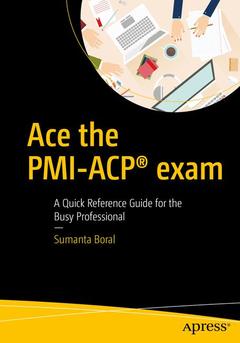Description
Ace the PMI-ACP® exam, 1st ed.
A Quick Reference Guide for the Busy Professional
Author: Boral Sumanta
Language: English
Subject for Ace the PMI-ACP® exam:
Approximative price 68.56 €
In Print (Delivery period: 15 days).
Add to cartSupport: Print on demand
Description
/li>Contents
/li>Biography
/li>Comment
/li>
Prepare for the Project Management Institute?s (PMI®) Agile Certified Practitioner (ACP®) exam. Augment your professional experience with the necessary knowledge of the skills, tools, and techniques that are required for passing the examination. This is a comprehensive and one-stop guide with 100% coverage of the exam topics detailed in the PMI-ACP® Exam content outline. Rehearse and test your knowledge and understanding of the subject using the practice quizzes after each chapter, three full-length mock exams, and practical tips and advice.
You will be able to understand the Agile manifesto, its principles and many facets of Agile project management such as planning, prioritization, estimation, releases, retrospectives, risk management, and continuous improvement. The book covers Agile metrics and means of demonstrating progress. People management aspects such as behavioral traits, servant leadership, negotiation, conflict management, team building, and Agile coaching are explained.Whether you are a beginner or a seasoned practitioner, this book also serves as a practical reference for key concepts in Agile and Agile methodologies such as Scrum, XP, Lean, and Kanban.
What you will learn:
Presents relevant concepts in an easy-to-understand format, removing the unnecessary clutter and helping with learning, capability building, and retention
Overview of Agile methodologies, including Scrum, XP, Kanban, and Lean
Can be used as a handy reference by someone beginning with Agile, and a refresher for a seasoned Agile practitioner
These books may interest you

Agile for Project Managers 135.96 €



